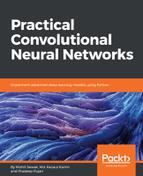After a certain depth, adding additional layers to feed-forward convNets results in a higher training error and higher validation error. When adding layers, performance increases only up to a certain depth, and then it rapidly decreases. In the ResNet (Residual Network) paper, the authors argued that this underfitting is unlikely due to the vanishing gradient problem, because this happens even when using the batch normalization technique. Therefore, they have added a new concept called residual block. The ResNet team added connections that can skip layers:

In the 2015 ImageNet ILSVRC competition, the winner was ResNet from Microsoft, with an error rate of 3.57%. ResNet is a kind of VGG in the sense that the same structure is repeated again and again to make the network deeper. Unlike VGGNet, it has different depth variations, such as 34, 50, 101, and 152 layers. It has a whopping 152 layers compared to AlexNet 8, VGGNet's 19 layers, and GoogLeNet's 22 layers. The ResNet architecture is a stack of residual blocks. The main idea is to skip layers by adding connections to the neural network. Every residual block has 3 x 3 convolution layers. After the last conv layer, a GAP layer is added. There is only one fully connected layer to classify 1,000 classes. It has different depth varieties, such as 34, 50, 101, or 152 layers for the ImageNet dataset. For a deeper network, say more than 50 layers, it uses the bottleneck features concept to improve efficiency. No dropout is used in this network.
Other network architectures to be aware of include:
- Network in Network
- Beyond ResNet
- FractalNet, an ultra-deep neural network without residuals
